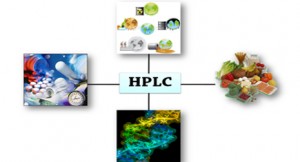“Success doesn’t come to you, you go to it”
— Marva Collins
After having gained exposure to High Performance Liquid Chromatography systems and their components we now introduce to typical applications.
HPLC has contributed to analytical solutions in diverse fields such as pharmaceuticals, foods, life sciences, environment, forensics, etc. In the present module we shall discuss some application areas in pharmaceuticals and foods.
Pharmaceuticals
High Performance Liquid Chromatography provides reliable quantitative precision and accuracy along with a high linear dynamic range to allow determination of API and related substances in a single run. A convenient method for sample preparation for solid dosage forms is dispersion in water or aqueous media modified with acetonitrile or methanol .HPLC offers several possibilities for separation of chiral molecules into their respective enantiomers.These include precolumn derivatization to form diastereomers. Alternately, specialty columns prepared with cyclodextrins or special chiral moieties as stationary phases maybe used .In short HPLC, particularly reverse phase HPLC is the most popular choice for quantitative analysis in the pharmaceutical industry.
Common application areas in pharmaceutical analysis are :
• Assay
• Related Substances
• Analytical Method Validation
• Stability Studies
• Compound Identification
• Working Standards
Foods
High Performance Liquid Chromatography has brought desirable advantages in the field of food analysis. Food matrices are generally complex and extraction of analytes is not an easy task. To further complicate matters both desirable and undesirable components are often found in trace levels and classical extraction and analysis does not provide the required levels of accuracy and precision. HPLC offers viable solutions due to vast choice of stationary phases and mobile phase options. Common applications in foods are :
• Fat soluble vitamins (A,D,E and K)
• Water soluble vitamins (B-complex vitamins such as B1, B2, B3, B6, Folic acid, Pantothenic acid, B12, VitaminC)
• Residual pesticides such as 2, 4-D and Monochrotophos.
• Antioxidants such as TBHQ, BHA and BHT.
• Sugars: Glucose, Fructose, Maltose and other saccharides.
• Cholesterol and sterols
• Dyes and synthetic colours.
• Mycotoxins such as Aflatoxins B1,B2,G1,G2,M1,M2and ochratoxin
• Amino acids
• Residual antibiotics
• Steroids and flavanoids
• Aspartame and other artificial sweeteners.
• Active ingredients of farm produce such as allin in garlic and catachin in tea extracts.
We are sure that you have gained valuable insight into basics and applications of High Performance Liquid Chromatography . Our final module will cover 10 frequently asked questions on HPLC technique that you may encounter in job interviews.
We hope you found the e-learning free course informative and useful.
HPLC analysis requires constant flow of mobile phase for which robust and reliable pumps are necessary. Equally important is constant volume injection. Module -9 exposes you to the wide range of applications particularly in pharmaceuticals and foods. The concluding module has covered some general questions which you may expect if you face an interview for a career with prospects for HPLC handling and operation..
The certificate course offers you a thorough understanding of laboratory requirements and practices related to HPLC analysis The program has been made participative through webinars, discussion forums and quiz sessions .
Please take this opportunity and register for the programme through the link https://lab-training.com/product/join-our-certificate-course-on-hplc/
P.S
Did you get here from a link from a friend, or Twitter? This lesson is part 9 of 10 parts High Performance Liquid Chromatography Free e-course. To get more information about it and sign up Click here.


